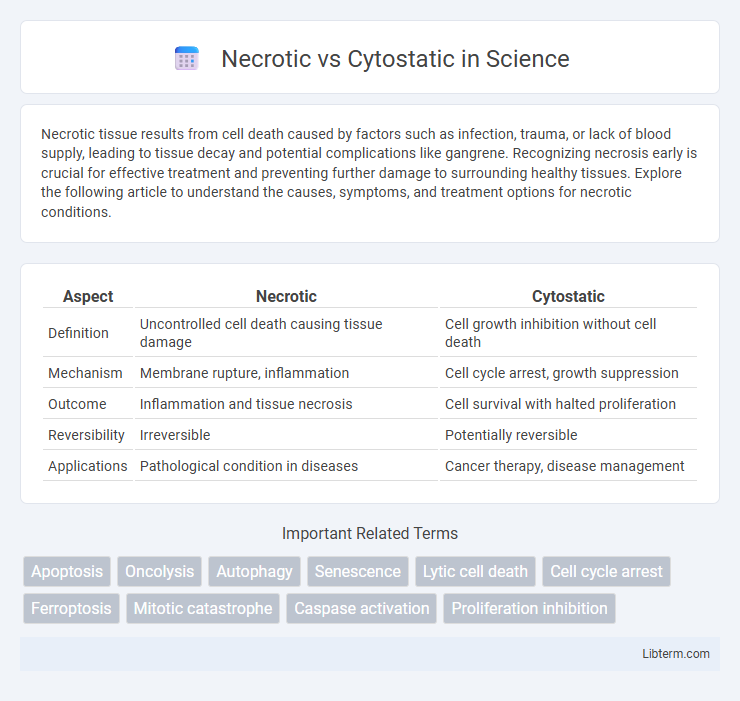Necrotic tissue results from cell death caused by factors such as infection, trauma, or lack of blood supply, leading to tissue decay and potential complications like gangrene. Recognizing necrosis early is crucial for effective treatment and preventing further damage to surrounding healthy tissues. Explore the following article to understand the causes, symptoms, and treatment options for necrotic conditions.
Table of Comparison
| Aspect | Necrotic | Cytostatic |
|---|---|---|
| Definition | Uncontrolled cell death causing tissue damage | Cell growth inhibition without cell death |
| Mechanism | Membrane rupture, inflammation | Cell cycle arrest, growth suppression |
| Outcome | Inflammation and tissue necrosis | Cell survival with halted proliferation |
| Reversibility | Irreversible | Potentially reversible |
| Applications | Pathological condition in diseases | Cancer therapy, disease management |
Introduction to Cell Death Mechanisms
Necrotic cell death results from acute cellular injury causing uncontrolled membrane rupture and inflammation, while cytostatic effects inhibit cell proliferation by arresting the cell cycle without directly killing cells. Understanding these mechanisms is crucial in disease pathology and therapeutic strategies, as necrosis often triggers immune responses whereas cytostasis aims to halt tumor growth. Key molecular pathways involved include ATP depletion and membrane disruption in necrosis, versus cyclin-dependent kinase inhibition in cytostatic processes.
Defining Necrotic and Cytostatic Processes
Necrotic processes involve the uncontrolled death of cells caused by external factors such as injury, toxins, or infection, leading to cell swelling, membrane rupture, and inflammation. Cytostatic processes inhibit cell growth and proliferation without causing cell death, primarily by arresting the cell cycle or interfering with cellular division mechanisms. Understanding the distinction between necrotic and cytostatic mechanisms is crucial for developing targeted therapies in cancer treatment and tissue regeneration.
Key Differences Between Necrotic and Cytostatic Effects
Necrotic effects cause irreversible cell damage leading to cell membrane rupture and uncontrolled cell death, often triggering inflammation in surrounding tissues. Cytostatic effects inhibit cell proliferation by arresting the cell cycle without causing immediate cell death, allowing for controlled growth suppression. Key differences include necrosis being a form of passive cell death with structural degradation, while cytostasis is an active process that halts cell division and preserves cell viability.
Cellular Pathways Involved in Necrosis
Necrotic cell death primarily involves the disruption of cellular energy production and loss of membrane integrity through pathways such as oxidative stress-induced mitochondrial dysfunction and lysosomal membrane permeabilization. These pathways lead to uncontrolled release of intracellular components, triggering inflammation and tissue damage. Unlike cytostatic mechanisms that halt cell proliferation by affecting cell cycle regulators or metabolic checkpoints, necrosis activates signaling cascades involving reactive oxygen species (ROS) accumulation and calcium overload, resulting in irreversible cell swelling and plasma membrane rupture.
Molecular Mechanisms of Cytostasis
Cytostasis involves the molecular regulation of cell cycle checkpoints, primarily through the activation of cyclin-dependent kinase inhibitors such as p21 and p27, which halt cell proliferation by preventing progression from G1 to S phase. Necrotic processes, contrastingly, are characterized by uncontrolled cell death due to membrane rupture and inflammation, lacking the regulated molecular signaling seen in cytostasis. The key molecular distinctions lie in cytostasis activating tumor suppressor pathways like p53, while necrosis results from ATP depletion and oxidative stress without checkpoint-mediated growth arrest.
Clinical Implications: Necrotic vs Cytostatic Responses
Necrotic responses in clinical settings often indicate irreversible cell damage leading to inflammation and tissue dysfunction, complicating patient prognosis and requiring targeted anti-inflammatory interventions. Cytostatic effects, characterized by the inhibition of cell proliferation without cell death, are crucial in cancer therapy for controlling tumor growth while minimizing tissue damage. Understanding the balance between necrotic and cytostatic outcomes guides treatment strategies, enhancing efficacy and reducing adverse effects in diseases such as cancer and chronic inflammatory conditions.
Diagnostic Markers for Necrosis and Cytostasis
Diagnostic markers for necrosis include elevated levels of lactate dehydrogenase (LDH), propidium iodide uptake, and release of intracellular enzymes such as creatine kinase (CK) due to cell membrane rupture. In contrast, cytostatic effects are identified by cell cycle arrest markers like increased expression of cyclin-dependent kinase inhibitors (p21, p27) and reduced DNA synthesis measured via bromodeoxyuridine (BrdU) incorporation assays. Immunohistochemical staining of apoptotic versus necrotic markers such as cleaved caspase-3 (active in apoptosis but not necrosis) also helps differentiate necrosis from cytostasis in diagnostic evaluations.
Therapeutic Strategies Targeting Necrotic and Cytostatic Pathways
Therapeutic strategies targeting necrotic pathways focus on inhibiting uncontrolled cell death to prevent inflammation and tissue damage, often employing necroptosis inhibitors such as necrostatins. Cytostatic pathway interventions aim to halt cell proliferation through agents like cell cycle inhibitors and mTOR blockers, effectively controlling tumor growth without inducing cell death. Combining necrotic and cytostatic pathway modulators enhances treatment efficacy by simultaneously reducing inflammatory responses and limiting cancer cell division.
Case Studies: Necrotic vs Cytostatic Outcomes in Disease
Case studies comparing necrotic and cytostatic outcomes reveal distinct therapeutic implications in disease management, particularly in cancer treatment. Necrotic cell death often triggers inflammatory responses that can exacerbate tissue damage, whereas cytostatic mechanisms halt cell proliferation without inducing immediate cell death, favoring tumor growth control and minimizing collateral damage. Clinical data from studies on solid tumors indicate that cytostatic agents improve disease stability and patient survival rates compared to necrosis-inducing therapies, which may lead to tumor necrosis but also increase adverse inflammatory effects.
Future Perspectives in Necrotic and Cytostatic Research
Future perspectives in necrotic and cytostatic research emphasize the development of targeted therapies that exploit distinct cellular death pathways for improved cancer treatment efficacy. Advances in molecular profiling and high-throughput screening techniques enable precise identification of biomarkers that differentiate necrotic cell death from cytostatic effects, facilitating personalized medicine approaches. Integration of nanotechnology and bioinformatics is anticipated to enhance drug delivery systems and optimize therapeutic windows, minimizing side effects while maximizing antitumor responses.
Necrotic Infographic

 libterm.com
libterm.com